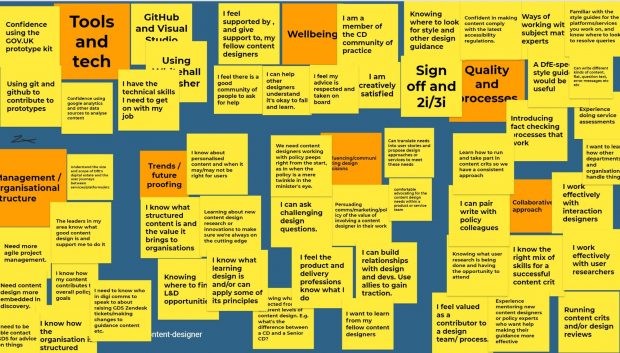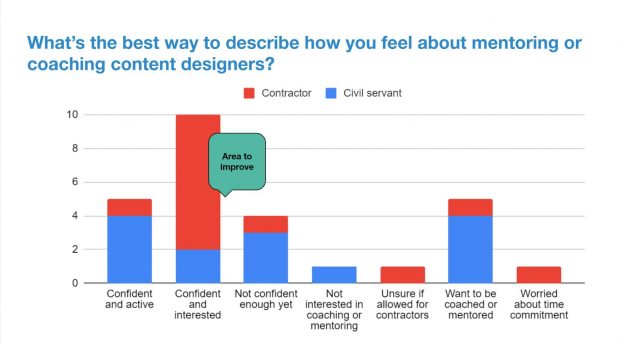
Content designers love evidence. So when I became head of profession and the content design community lead, I needed to start thinking about a roadmap for our profession. I wanted evidence.
The content design profession is dispersed throughout the Department for Education. We’ve got content designers working in multidisciplinary teams in our Digital and Technology directorate, in the Education and Skills Funding Agency, and a team of content designers in the digital communications team.
We’re a mix of contractors and civil servants and we’re scattered across the country in different delivery teams in London, Sheffield, Manchester and Coventry.
I wanted to find out what skills and capabilities we had individually, as a community, as an organisation as a whole, and within our smaller teams.
The goal was to understand what content designers wanted and needed, and then use that to inform our content design roadmap. The results were not about trying to hit a certain target, but about understanding roughly where we were.
We planned and designed a programme of work, and we aim to run the survey again in a year.
Finding out what skills and capabilities we already have
Sometimes people consider capability and skills to be the same thing. A skill is something you learn to do a specific thing, but capability is a deep-rooted ability, which can be applied in many contexts.
Inspired by some work I did as part of the content design team at the Department for International Trade, I set out on a capability-finding mission at DfE. I wanted to know:
- what technical skills our content designers have, like prototyping
- what ‘soft’ skills they have, like stakeholder engagement. How confident were they using them?
- how confident they were about writing different types of content, such as transactional services content, metadata or alt-text
- how they felt collaborating with other members of the multidisciplinary team, like service designers, interaction designers and user researchers – or with policy and comms colleagues
- how many were active members of the content design community
- what their relationship was with mentoring and coaching
- whether they understood DfE’s digital estate and how it connected, and whether they felt DfE understood the role of the content designer and the value it brought
- what areas or future capabilities they were most interested in learning more about
At a content design community meet-up I ran a workshop to hear people’s thoughts about how to refine this long list into categories in the survey.
We got some great ideas and agreed the categories should be:
- tools and technology
- quality and standards
- collaborative working
- advocacy and influence
- community
- wider DfE
The survey was anonymous: it can feel tricky to talk about what you feel confident and not confident doing in the workplace.
The results showed us where to focus our efforts

Eighty percent of 50 content designers dotted around DfE responded. It was an even mix of civil servants and contractors.
I’d love to take you through each and every question (honestly, it's fascinating!) but here are some of the top insights we gleaned.
Some content designers have important technical skills — using GitHub and the GOV.UK prototyping kit, for example — and these allow content designers to add more value. Targeted learning and development outside our community would help, like joining up with our interaction design community, or joining a cross-government training effort.
The community of practice is a safe, supportive space already for many, but can do more to meet content designers’ needs.
Data and evidence (beyond user research) are fundamental to content design work, so performance analysis expertise needs to be developed across DfE Digital and Technology.
Content designers don’t always feel supported outside their teams, and there is work to do at leadership level to improve this.
Within the user-centred design family (content design, service design, interaction design and user research), content designers feel least confident working with service designers. But of all the disciplines, this is the one they're most keen to learn about.
Contractors are consistently more confident in their skills, but less engaged in the community. We should do more to engage them and ensure we transfer some of their skills to our civil servants.
These insights, along with a few others, inform the first iteration of our content design roadmap. It’s really exciting to see, and we now have 8 areas for improvement.
Our evidence gathering method can be reused by other communities that need a roadmap
We’ll work with colleagues across DfE to establish a plan and align work. The hope is for content designers to step up to develop and progress some of these areas, so that it’s truly a community effort. And for content designers, who can often feel disconnected from one another when they are embedded in separate teams, that’s a powerful reason to come together.
I’m excited for the future, and what we can do together as a community of practice.
When I shared the survey and results with the other heads of profession, I was pleased that many of their first responses were that they’d like to run something similar. The good news is: you can.
This is not something bespoke to content designers, though it’s a natural fit because of our love for data, user needs and structure.
Here’s my 10-point guide
If you’d like to run something like this, here's how.
Start with any frameworks you have
I started with the DDaT capability framework for content designers.
Co-design it with your community
Run an exercise with them to pull out what they think the main capabilities or needs are that you should survey. You might find there are capabilities that are nowhere to be found in a framework but that are essential for your organisation.
Refine your list
You can’t include everything, but you also want to be comprehensive.
Think about the main cuts of data you’ll need
Is it important to be able to distinguish between contractors and civil servants, for example, or across different parts of the business? Make sure you get those questions in.
Draft your survey questions
Be cautious about leading questions, and be mindful of matrix questions (closed-ended questions that ask you to rate multiple items in one question). These can encourage tick-boxing. When in doubt, come back to — what do you really want to know?
Build your survey
Use Google Forms, MS Forms, whatever suits or organisation. Make sure it will be inclusive of everyone who needs a say.
Get at least 2 others to review
Ideally ask someone in your profession, and someone who is not, so they can call out jargon or acronyms.
Send it out on multiple channels
Slack, email, word of mouth. And don’t be afraid to follow up with some friendly reminders.
Dig deeper into the data
Google will give you top-line results, but if you pull the raw data into Excel or Sheets you can really start to get to some fruitful insights. If you struggle with that, consider a skill swap with someone who’s good at data.
Share widely
Share with your community and discuss results. Share with your peers. Share with your leaders. If you need to advocate for your community (and often content design as a discipline is pushing for wider recognition), data can be a powerful tool for advocacy and to spark conversation.
Once the other heads of profession run their sessions, we’ll join up. We want to see where areas overlap, and where we can work together to share budget and resources and run masterclasses. The possibilities are endless.
Is this something you’d like to try? Let us know in the comments or tweet @jenstaves.
You can follow DfE Digital and Technology on Twitter.
Subscribe to our blog.
Recent Comments